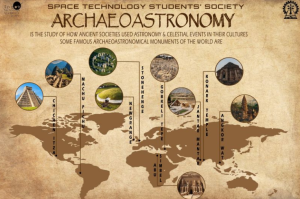Archaeoastronomical Sites: Mapping Ancient Skies
Archaeoastronomy is the study of how ancient societies used astronomy and celestial events in their cultures. Scientists in this field examine ancient buildings, artifacts, and writings to understand how people in the past observed the stars and planets. By looking at things like how monuments were aligned with the sun or stars, decoding symbols related to astronomy in art and architecture, and studying ancient calendars and beliefs about the cosmos, archaeoastronomers piece together how ancient civilizations viewed and interacted with the sky. Civilizations around the globe have looked to the heavens for guidance and inspiration. Through careful analysis and research, archaeoastronomy helps us learn more about how astronomy influenced the development of human societies and their beliefs.
Across the globe, archaeoastronomical sites reveal how ancient civilizations observed and understood the skies. These locations provide insight into celestial cycles, agricultural planning, ritual practices, and even long-term communication through precise alignments. From Asia to the Americas, these sites demonstrate extraordinary knowledge of astronomy and landscape design.

Asia
-
Angkor Wat, Cambodia – A temple facing west rather than east, possibly marking a funerary orientation rather than the typical solar alignment.
-
Phnom Bakheng, Cambodia – The central tower represents the axis of the world, surrounded by 108 smaller towers corresponding to lunar cycles.
-
Jantar Mantar, India – A 18th-century astronomical observatory capable of measuring time to half a second and tracking solar declination.
Australia
-
Ngaut Ngaut – A lunar calendar engraved in stone, tracking the moon’s phases.
-
Ku-ring-gai Chase National Park – Rock engravings reflecting solar and stellar phenomena, linking culture with celestial observation.
Europe
-
Karahunj Zorats Karer, Armenia – Stone observatory aligned to solstices.
-
Metsamor, Armenia – Metalworking site featuring stones arranged in astronomically significant patterns.
-
Cham de Bondons Menhirs, France – 150 standing stones with 30 burial mounds, the second-largest concentration in Europe after Carnac.
-
Carnac, France – Over 3,000 stones aligned in long rows, demonstrating precise prehistoric engineering.
-
Goseck Circle, Germany – Concentric ditches and palisades functioning as a solar calendar.
-
Brú na Bóinne & Newgrange, Ireland – Neolithic tombs with solstice alignments; at Newgrange, sunlight illuminates the inner chamber for 17 minutes at winter solstice.
-
Mnajdra, Malta – Three temples aligned to equinox and solstice sunrises.
-
Almendres Cromlech, Portugal – 92 menhirs arranged to track equinox directions with remarkable precision.
-
Arkaim, Russia – Compared to Stonehenge, with multiple astronomical alignments.
-
Ale’s Stones, Sweden – 59 stones forming a calendar of 365 days and 24 hours.
-
Gotland Grooves, Sweden – Semi-circular grooves possibly marking lunar positions.
-
Callanish Stones & Maeshowe, UK – Standing stones and chambered tombs aligned to midsummer moon and winter solstice.
Middle East
-
Abu Simbel, Egypt – Biannual sun illumination highlights the back wall, leaving the underworld god Ptah in shadow.
-
Great Pyramids, Egypt – Oriented to True North with astonishing precision.
-
Nabta Playa, Egypt – Prehistoric calendar circle older than Stonehenge, aligned to the summer solstice.
-
Gilgal Refaim, Israel – 42,000 basalt rocks in circles, likely from the Copper Age.
The Americas
-
Tiwanaku, Bolivia – Monoliths and semi-subterranean temples with precise orientation.
-
Amazon Stonehenge, Brazil – 127 granite blocks, some aligned to the winter solstice.
-
Chichen Itza, Dzibilchaltun & Teotihuacan, Mexico – Observatories and pyramids aligned with solar and Venus cycles.
-
Xochicalco, Mexico – Cave observatory tracking the sun’s path.
-
Buena Vista, Thirteen Towers of Chankillo & Cusco, Peru – Sites aligned to solstices and the sun’s movement.
-
Intihuatana Stone, Machu Picchu, Peru – “Hitching Point of the Sun” for solstice observations.
-
Nazca Lines, Peru – Giant geoglyphs, possibly for celestial or ritual observation.
-
Chaco Canyon, USA – Buildings and the “Sun Dagger” petroglyph aligned to solar and lunar cycles.
Conclusion
These archaeoastronomical sites demonstrate that ancient peoples were not only observers of the heavens but also skilled engineers and planners. Their alignments, often to the sun, moon, and stars, reveal a deep understanding of celestial mechanics and an enduring desire to connect human life with the cosmos. Each site — from the deserts of Peru to the hills of Ireland — is a testament to the intelligence, ritual, and creativity of our ancestors.





